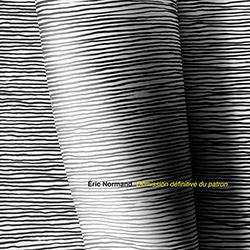
My first assignment for Squidsear in 2009 was Face à la derive, an album that features Éric Normand on "bass, loudspeaker, percussion, and voice." It's a field recording project lead by electroacoustic musician Sébastien Cirotteau wherein a quartet of players weaves throughout a wordless, arboreal narrative (source material collected near Saint Lawrence River while on tour). A murky, who's-making-that-noise augmented reality, the only mention of Normand I offered here was, "...while Normand bangs on whatever he can find until a niente." Nailed it.
To be present but not obvious is intentional on Normand's part, however. He once suggested that his path is an echo of interactive media artist Serge Lemoyne in that, "The artist of today is a producer; he is not the skilled craftsman, but the one who makes things happen." Normand: "I can relate to this. I make no distinction between playing my own music or bringing great musicians to the same room." (And then disappearing into the mix.)
Likewise for the title work, you wouldn't imagine that five permutations of the bass guitar + manipulation via electronics and acoustic "extended" accoutrement could stay largely anonymous and keep out of the way of flautist (and electronics, motors, objects) Camille Brisson. The aesthetic during the warm-up is that the sonic output of a clutch of trees all gently vibrating in synchronization, ebbing without rising above a rumble.
(I frequently advise, "This is best experienced with headphones," and I mean it this time. At a glance — only hearing the louder bits due to multi-tasking at one's desk or raking leaves — the piece appears to be a series of "lines" in loose homage to what Scelsi did on the symphonic level; other than going forward due to time's pull, the form isn't concerned with direction as much as being a nebulous display of sound design and pauses. But there's more to it to than that.)
Digging in with headphones, there is a teeming ecosystem chattering at ppp a few octaves down. Regardless of dynamic marking, there is no hierarchal preference of background or foreground; each strata is crucial and united in Klangfarbenmelodie, the twelve-tone technique where "melody" is split and shared across the ensemble — à la the baton handoff in a decathlon. In this way, Normand herds the often aleatoric, self-organizing participants with a tether to clutch — even if it's thread-bare, such as slight brushes across a surface or the groan of bass guitar when its strings are stretched and squeezed. With regard to the sound design comment, there are hundreds of these instances where a new timbre will pop in, politely introduce itself, hold until completion and never return. Rattling bowls, sudden and overwhelming clouds of reverb and electrical pings, fleets of tin ratchet noise makers, fuzz pedal depravity, lap steel emulations, and strings plucked and left alone to decay with the brazen attitude and matching guitar face of anyone who has felt the power of plugging into an amp can all be heard and examined equally.
The final piece, "Le saxophone est un media" (for soprano, alto, tenor, and baritone saxophone), begins with a juicy, warbling four-part chord that dabbles in ahooga car horns as it swells and deflates. The pitch-focus is playful and somber, lingering near Bartok and Messiaen with an equal tap into the intimacy displayed in both composer's chamber works; the most interesting moments are rhythmic and come when bell burps, thin hisses and key clacks assemble into multi-metered drum loops. There is relatively more interaction between performers, though the work still follows Normand's penchant for staggered scenes of different sizes delineated like a slide show.
I have to share this. It takes a while to absorb and then offer an educated, accurate account about niche art, especially under conditions where all I want is familiarity and security between my daily book-ends. In an effort to distract myself that day, I added a splash of monochrome to my wall with a framed sleeve of Cage and Tudor's Variations IV. I then pressed play on a video performance of Démission définitive du patron while reading about Normand's affinity for Cage's "something from nothing" lesson. I don't hear anything, turn to focus on the screen, and marvel at the visual urgency of movement these players were giving to what might be an intentional, exciting, tense, tribute to Cage's 4' 33". While scribbling, "Saying nothing to an audience who expects something is the last punk rock flex," I note that my speakers are muted and text a friend, "I liked this record better before I heard it" (I rescind this statement). "Is that a self pwn, John Cage style?" he asks. Possibly, but I'm more inclined to believe that I ticked off the boxes of an obscure Black Mountain College ceremony to earn a nerdy, personalized visitation from The Trickster himself. He eschewed typing "Dave, you are special" and the low-hanging supernatural spell-check to instead reach out a heavenly finger and deliver a base, inside joke I can appreciate. I could imagine his gregarious laughter erupting as he and Kurt Vonnegut plan their next gift for this holiday season of our discontent. The power of Cage and his Canadian acolyte can compel me anytime.
Comments and Feedback:



More Recent Reviews, Articles, and Interviews @ The Squid's Ear...


|

